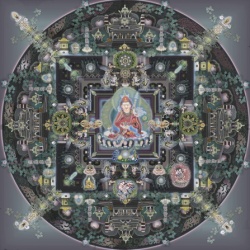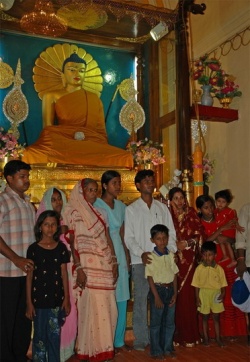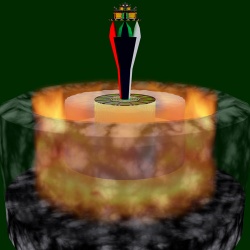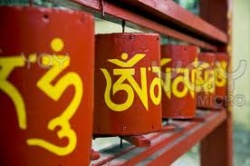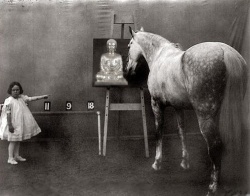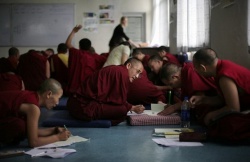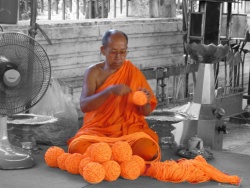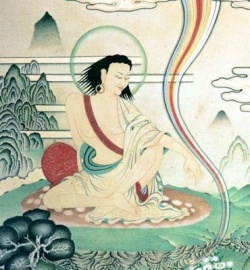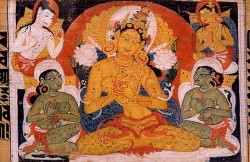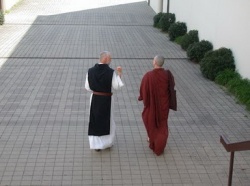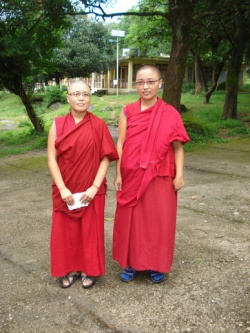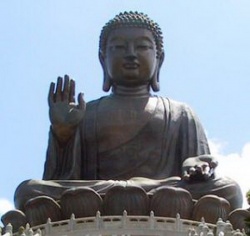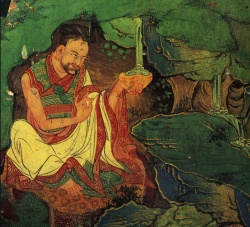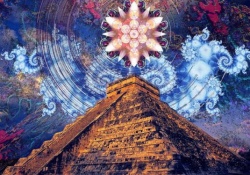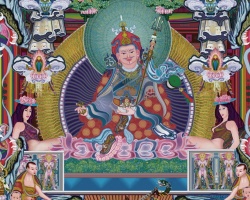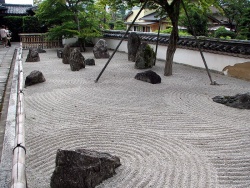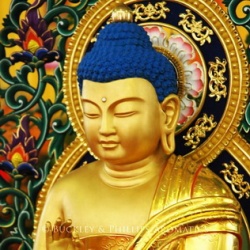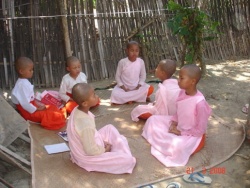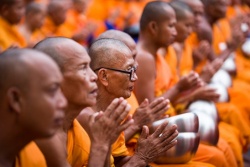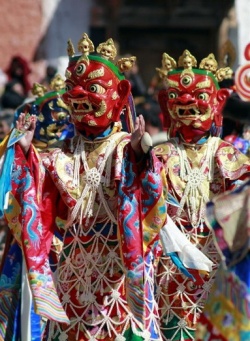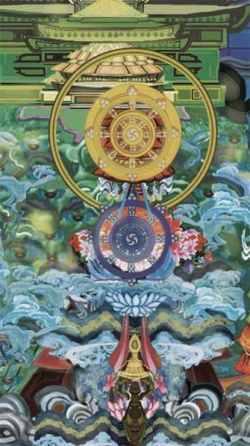Deprofessionalisation of Buddhist Priests in Contemporary Japan
A Socio-Industrial Study of a Religious Profession[1]
by
Mitsutoshi Horii
Lecturer
Shumei University
Since the 5th century, Buddhist priests had existed as a distinctive group in Japanese society. However, since the mid-19th century, especially during the post-1945 era, Buddhist priests as an occupational group have been deprofessionalised within the rapid reorganisation of the Japanese social system. There is no independent occupational category called 'Buddhist priests' in the current Japanese socio-economic statistics. The professional jurisdiction of Buddhism has been increasingly invaded by so-called lay Buddhist organisations. In addition, occupational activities of Buddhist priests are increasingly subordinated by other professions. Further, various occupational activities currently performed by Buddhist priests and their temples may be deviated from ones defined by the law. This is the context in which Japanese Buddhist priests have been deprofessionalised.
Introduction
Deprofessionalisation can be defined as 'a loss to professional occupations of their unique qualities, particularly their monopoly over knowledge, public belief in their service ethos, and expectations of work autonomy and authority over client' (Haug, 1973: 197). A professional occupation, or a profession, is not simply a job. Sociologically speaking, a profession can be defined as 'a type of higher-grade, non-manual occupation, with both subjectively and objectively recognised occupational status, possessing a well-defined area of study or concern and providing a definite service, after advanced training and education' (Millerson, 1964: 10). However, a particular occupational group may lose its status as professional. This process is called deprofessionalisation. The aim of this article is to show that the process of deprofessionalisation has affected Buddhist priests in contemporary Japan, who are examined here as a discrete occupational group.
From government statistics in 2003, we can estimate that there are about 75,000 Buddhist temples in Japan (Bunkachō, 2004), comprising one thirtieth of all corporate bodies (Nakajima, 2005). It can also be estimated that there are more than 300,000 'Buddhist doctrinal instructors' who have been qualified by Buddhist organisational bodies (Bunkachō, 2004). Another estimation tells us that there are over 200,000 such instructors, which is, notably, almost the same as the number of soldiers in the Japanese Self-Defence Forces (Zen Nihon Bukkō Seinen Kai, 2003: 67). In addition, government statistics show that 75% of the Japanese population (about 95 million) consider themselves to be Buddhists (Bunkachō, 2004).
In contrast to these statistics, most Japanese people rarely go to Buddhist temples and they hardly talk to Buddhist priests. According to a survey conducted by Sōtō-shū, the largest Zen Buddhist denomination in Japan, in 1984 only 7 per cent of the laity visited temples for what they termed spiritual reasons (Reader, 1986: 12). In addition, a survey asked 5,759 Japanese university students whether they would consult religious professionals, such as Buddhist, Shinto, or Christian priests, street fortune-tellers, and others, if they had a crisis in their lives. The survey showed that only 11 per cent would go to Buddhist priests, while more than 55 per cent would not talk to any religious professionals (Sankei Shinbun, 1999). These figures may suggest at least that a significant majority of the Japanese population have little need of Buddhist priests for their everyday personal problems.
The occupational status of Japanese Buddhist priests as religious professionals has been severely undermined. Buddhist priests were a distinctive social group until the end of the Second World War. In post-1945 Japan, however, they are no longer an officially recognised social group. In addition, their occupational activities have been alienated from their legally defined occupational role as 'religious professionals'. This article discusses what can be termed as the deprofessionalisation of Buddhist priests in post-war Japan. First, some key terms used throughout this article are explained. The next section outlines the historical development of Buddhist priests, leading to structural deprofessionalisation during the post-1945 era and, following on from this, the article examines how Buddhist priests' various occupational activities in contemporary Japan have been deprofessionalised.
Key Terms
It is extremely difficult to define exactly who Buddhist priests are. In Japanese occupational statistics no group of people is distinctively categorised as Buddhist priests. One may suppose that Buddhist priests are those who work full-time for particular religious corporations which claim to be Buddhist. However, there are a number of workers for Buddhist religious corporations who claim to be lay Buddhist leaders rather than Buddhist priests. In order clearly to identify Buddhist priests, however, we need to go through some other terms which need to be used. These terms are religion, religious corporations, religious professionals, Temple Buddhism, New Religions, lay Buddhist organisations, and denomination.
Buddhism is usually referred to as a religion. The concept of religion is an extremely ambiguous term. It is often defined as a belief or belief system concerning the supernatural, sacred, and divine, which in themselves are also highly ambiguous terms. Although what the word actually means varies in different contexts, one may understand that religion is particular theological knowledge, shared value, or collective sentiment. Alternatively, one may mean a group of people who share a sense of devotion to the same ultimate truth. According to Koizumi et al. (1982), the Japanese term for religion, shūkyō has a Buddhist origin. Up to the end of the nineteenth century, shū denoted a particular interpretation of the teaching of Buddha, while kyō referred to the teaching itself. In other words, the former indicates different ways of understanding Buddha's teaching which developed to become different schools, while the latter was what was believed to be the fundamental truth in Buddha's teaching. However, during the Meiji period, shūkyō gradually came to mean many other belief systems including foreign ones such as Christianity and Islam, and began to be used as a translation of the English term, religion. In addition, Isomae (2003; 2005) argues that the Japanese term shūkyō was socially constructed in post-1868 Japanese history, and especially under the heavy influence of religious studies imported from the West. Therefore, one may assume that the meaning of shūkyō varies according to discourses constructed in particular social contexts.
In this particular study, however, religion is conceptualised as an industrial category which is part of the service industry in contemporary Japan. Thus, the word religion (and its adjective, religious) is limited only to indicate an industrial category used in Japanese socio-economic statistics, within which it is further divided into four statistical categories; Shinto, Buddhism, Christianity and others. The word Buddhism, therefore, is used to indicate a subdivision of the industrial category religion.
Along with religion, the service industry in Japan includes such subcategories as advertising businesses, broadcasting, social welfare businesses, academic research institutions, political/economic/cultural associations, car repair businesses, disposal businesses, education, medical institutions, car park businesses, and so forth (Statistics Bureau, 1996-2005). Religion consists of religious corporations. Out of all the corporate bodies in the service industry, those of religion occupy 6.3 per cent (95,000) (Statistics Bureau, 1996-2005). The Ministry of Cultural Affairs classifies religious corporations as a subtype of so-called public interest corporations. Article 34 of the Civil Code defines a public interest corporation as 'an incorporated association or foundation relating to worship, religion, charity, science, art, or otherwise relating to public interest and not having for its object the acquisition of gain'[2] (Amemiya, 1998: 63). The subtypes of public interest corporations are private school corporations, social welfare corporations, medical corporations, and religious corporations.
Religious corporation is a legal term in Japan. This is an English translation of the Japanese term shūkyō hōjin. As discussed, the Japanese term shūkyō means religion in English, and hōjin can literally be translated as juridical persons. The Japanese law grants rights and responsibilities to two fundamental units; natural persons and juridical persons. The former are human beings while the latter refers to entities established under law to which rights and responsibilities are attributed. The religious corporation is one type of juridical person. According to the Religious Corporation Law (1951, Law No. 126), a religious corporation is defined as a juridical person 'whose main purposes are to propagate religious teachings, perform rituals, and teach and foster a following' (Amemiya, 1998: 75). On this basis, the organisations dedicated to these purposes are entitled to be given, by the government, the status of religious corporations. Buddhist priests are in most cases formally qualified and employed by their own respective religious corporations to specialise in various activities for their organisational purposes. In this article, those activities particularly directed towards organisational purposes of religious corporations are termed religious activities.
In Japanese socio-economic statistics, Buddhist priests are classified under two different statistical categories. In the Japanese population census issued by the Statistics Bureau, Buddhist priests are a subcategory of shūkyōka. The term can be translated as religious professionals in English. Religious professionals are those who specialise in the propagation of religious teachings, perform rituals, and teach and foster a following. In other official statistics issued by the Agency of Cultural Affairs, kyōshi is the term which refers to a similar group which can literally be translated as teachers, clergy (Agency for Cultural Affairs, 1972), or doctrinal instructors (Jaffe, 2001). This term denotes those who are formally qualified by their respective professional body to teach its doctrine. While the former term, shūkyōka, is an occupational category, the latter, kyōshi, implies a certain qualified status. In this article, therefore, the term Buddhist priests denotes those who are both religious professionals and qualified doctrinal instructors.
In order to identify Buddhist priests more clearly, the term Temple Buddhism[3] is employed. This term was coined by Stephen Covell (2001) in his PhD thesis on Japanese Tendai Buddhism. The term 'refers to the Buddhism as lived by the members of the sects of Japanese Buddhism that were founded before the 1600s', except for Ōbaku-shū which was founded in Japan 1654 (Covell, 2001: 7). In pre-war Japan, those Buddhist establishments were reorganised by the government into 13 schools and 56 sub-schools. The 13 schools are as follows: three Nara schools (Hossō - 法相, Kegon - 華厳, Ritsu - 律), the Tendai - 天台 school, the Shingon - 真言 school, four Pure Land schools (Jōdo - 浄土, Jōdo Shinshū - 浄土真宗, Ji-shū - 時宗, Yūzū-nenbutsu-shū - 融通念仏宗), three Zen schools (Sōtō - 曹洞, Rinzai - 臨済, Ōbaku - 黄檗) and the Nichiren (日蓮) school. During the Second World War, the government issued the Religious Organisation Law which forced these religious bodies to amalgamate into 28 schools. However, post-war legislation liberated them so that many groups which had been forced to amalgamate during the war separated. Some powerful temples broke off from their schools and sub-schools. This reorganisation resulted in the current number of 157 schools (Bunkachō, 2004).
In this light, Temple Buddhism is differentiated from other religious corporations and other Buddhist religious corporations which have been established more recently. Those relatively new religious corporations are often called New Religions. For example, during the period between 1860 and 1895, the New Religions called Tenri-kyō (天理教), Konko-kyō (金光教), Honmon Butsuryu-shū (本門仏立講), and Maruyama-kyō (丸山教) were established. Between 1895 and 1920, Omoto-kyō (大本教) was established. PL (Perfect Liberty) Kyōdan (パーフェクト・リバティー教団), Reiyūkai (霊友会) and Seichō no ie (生長の家) were founded during the period between 1920 and 1945. The major religious organisations which were established in the period 1945 to 1970 were Sekai Kyūsei-kyō (世界救世教), Nempōshin-kyō (念法真教), Risshōkōseikai (立正佼成会), Soka Gakkai (創価学会), Bussho Gonen-kai (仏所護念会), Myōchikai (妙智会), and Zenrinkai (善隣会). In the decades since 1970, religious organisations such as Shinnyōen (真如苑), Byakkō Shinkō-kai (白光真宏会), Reiha no hikari Kyōdan (霊波之光教団), Oyama Nezunomikoto Shinji Kyōkai (大山ねずのみこと神示教会), and Sūkyō Mahikari (崇教真光) have been established. In addition, many of the New Religions claim to be Buddhist without having any formal ecclesiastical structure, but often with a modern bureaucratic administrative structure. These are generally called lay Buddhist organisations. This category includes such religious corporations as Reiyūkai, Risshōkōseikai, Soka Gakkai, Bussho Gonen-kai, Myōchikai and so forth.
By Buddhist priests, therefore, I mean religious professionals in Temple Buddhism. Here, the term religious professionals does not simply mean those who are employed by religious corporations, but those employees who are formally qualified as doctrinal instructors by their respective professional bodies to specialise in religious activities, which are carried out to propagate religious teachings, perform rituals, and teach and foster a following. Thus, the term Buddhist priests denotes those who are formally qualified in specialised religious activities in Temple Buddhism. The term priest can also be applied to those practising exclusively in monasteries as well as to trainees. The terms nuns and monks are often applied to the same group of people. Although the terms nuns and monks are often used to refer to those who renounce worldly life and take priestly preceptss we shall see, the distinction between lay followers and monastics has almost completely disappeared in contemporary Japan. Except for some particular historical context where such a distinction existed, the term priest is preferred here over the terms nun and monk.
Finally, I employ the term denomination, rather than sect, in order to refer to schools of Temple Buddhism. This is because their predominant characteristics do not seem to be those of sects, but rather of denominations. Sociologically speaking, a sect is a type of religious organisation which is characterised by strong integration and religious commitment amongst members and the presence of a charismatic leader (Troeltsch, 1981). This characterisation seems to be more applicable to New Religions than to branches of Temple Buddhism. For example, in his study, Wilson (1971) employs the term sect in order to refer to Japanese New Religions. In contrast, Temple Buddhism in general does not show strong integration. The religious commitment of its followers tends to be very loose and any presence of charismatic leaders is very difficult to discern. Temple Buddhism generally accepts the norms and values of society, and different branches often cooperate with each other in affairs of common interest. This is in fact very similar to what, for example, Neibuhr (1929) called denomination. Various sociologists employ this term to refer to Christian Churches, which are not mainstream but socially established, such as Methodists and Baptists. However, some scholars of Japanese Buddhism, such as Jaffe (1997; 1998; 2001) have already adopted the term for the study of Temple Buddhism. I employ the term in the same manner.
Historical Development of Buddhist Priests in Japan
Japanese Buddhism, like any other Buddhism, has its origin in ancient India. The Founder of Buddhism was Siddhartha, Shakyamuni, called Gautama Buddha, the Buddha. He was born in Lumbinī in present-day Nepal. The years when he was born and died are not confirmed, but he is widely believed to have been born in 624BCE and to have died in 544BCE. Buddhism was then brought to many parts of the world, and one of its many streams reached Japan in the 6th century through China and Korea. Since then, a number of different schools of Buddhism have developed within Japan.
Those who are identified as Buddhist priests have existed in Japanese society since the 6th century. This is particularly clear up to the end of the Second World War from the fact that there were a series of laws issued by Japanese political authorities, specifically targeted at Buddhist priests, monks, or nuns in the earlier period, who existed both inside and outside the official Buddhist establishments of the era. At the dawn of the 17th century, however, these people were systematically unified by the Tokugawa government (1601-1868) as a distinctive social group within the formal system of social stratification. As the government withdrew from the administration of Buddhist institutions during the latter half of the 19th century, and then especially in the post-1945 period, Buddhist priests ceased to exist as an officially recognised group and the boundary with other social groups became increasingly blurred amidst the rapid re-organisation of social structures during the modernisation of Japanese society.
Before 1945
In the 7th century, the government of the time noticed a rapidly increasing number of monks and nuns. In order to regulate their number, the government established a system for controlling entry to the monastery. This became necessary because an increase in the number of priests, who were a non-productive group within the population, would, it was thought, result in economic decline. The state also set up the system of regulations specifying state standards for clerical conduct which were codified as the Sōniryō (Statutes pertaining to Buddhist monks and nuns) in 701. An extended version of this can be found in the Yōrō ritsuryō (Penal code and administrative statutes of the Yōrō period). This was compiled in 718 and promulgated in 757. According to this first official precept, offences such as murder, stealing, fornication, and making misleading statements about one's spiritual achievement, would result in expulsion from the priesthood. In addition, monks were prohibited from staying in the same buildings as nuns, and nuns were prohibited from staying in temples. Other regulations prohibited the consumption of liquor and such foods as meat and strong-smelling vegetables.
In the earliest period up to the end of the 11th century, Buddhist priests derived funding from the imperial court and court nobles. However, as the political power of the imperial court and court nobles declined, the major source of funding shifted towards private estates owned and operated by the temples. In the Kamakura period (1192-1333) various other sources of funding were developed. In addition to incomes derived from temple estates, the temples received support from noble and warrior family households as well as from donation campaigns for raising funds.
In medieval Japan, Buddhist priests were also often political actors. They accumulated wealth, gained strong political power by establishing connections to prominent political figures, and often employed their own armed forces. At the same time, outside the establishments, various Buddhist orders developed in the villages and towns. Priests from these orders made their living by providing services according to religious demands of the commoners.
From the latter half of the 16th century, the Buddhist establishment was forced to accept an unprecedented degree of discipline by the temporal authorities. The great unifiers of the Japanese state, such as Oda Nobunaga (1534-1582), Toyotomi Hideyoshi (1536-98), and Tokugawa Ieyasu (1521-98), destroyed the military power of the Buddhist temples and strict precepts were enforced on the clergy, particularly aimed at the violation of the strictures against sexual liaisons and meat-eating (McMullin, 1984).
Once Tokugawa Ieyasu had unified the Japanese state at the beginning of 17th century, the rule of the Tokugawa family continued for over 250 years until 1868 and the Tokugawa government (1601-1868) imposed various rules and regulations upon Buddhist priests. First of all, the Tokugawa government hoped to establish a system in which the state had absolute legal authority over Buddhist temples. In 1635, in order to oversee this, the government set up the Office of Temples and Shrines which was put at the top of the administrative pyramid of religious institutions. As a result, all Buddhist institutions in Japan were linked through a hierarchical network. In 1665, the directive called shoshu shojiin hatto (Temple regulations for all denominations) was issued nationwide. The government codified clerical behaviour by this directive. It also clarified the organisational structure of Buddhist institutions and the hierarchy of priestly ranks, so that such institutional matters would come under the administrative control of the government.
Tokugawa Japan was composed of a complex hierarchy of different classes, including samurai, peasants, artisans, and merchants as well as nobles, domain lords, samurai retainers, Shinto priests, Buddhist priests, doctors, scholars, and outcastes. These social classes were further differentiated into subclasses. According to the status system, Buddhist clerics were ranked above the merchants and peasants and below the samurai. Unlike most other classes, however, entrance into the Buddhist clergy was the result of ordination, not birth, which also distinguished Buddhist priests from Shinto priests. Upon ordination, monks and nuns were given Buddhist names, which were recorded in the clerical register (sōseki). The clerical registers were maintained by the respective denominations, and the entire system of clerical registration was placed under the control of the temple magistrate (Jisha Bugyō) of the state. Buddhist priests were under the supervision of the head temple of their denomination and the government.
From the last decades of the Tokugawa era to the early Meiji period (1868-1912), Buddhist priests experienced an extremely violent assault on their institutions. The Meiji government sought its ideological foundation in Shinto, in particular the worship of those deities associated closely with the imperial family. This became the religious underpinning of imperial power. A series of edicts calling for separation of kami from Buddhas triggered an explosion of anti-Buddhist violence[4]. As a consequence a number of temples were trashed and looted. According to one estimate, out of 200,000 Buddhist temples in the Tokugawa period, only 74,600 survived after the early years of the Meiji period (Tamamuro, 1997).
Meiji political leaders were, however, striving to develop a policy of religious and political indoctrination that would encourage support for the emperor. In an effort to realise this goal, the government employed a corps of proselytisers to disseminate the National Teaching of Imperial Japan (kokukyō) throughout the population. These proselytisers included Buddhist priests because of their greater experience in teaching and proselytising. The incorporation of Buddhist priests into a Doctrinal Instructor System redefined their legal status as national doctrinal instructors, alongside other national proselytisers such as Shinto priests and popular entertainers.
Between 1868 and 1884, the Meiji government reconstructed state policy concerning clerical status, the definition of Buddhist priests, and the Buddhist institutional structure. For example, in 1872, the new government policy of the decriminalisation of clerical marriage and meat-eating erased many of the boundaries between laity and priests (Jaffe, 1998: 2001). However, this does not automatically mean that Buddhist priests ceased to exist as a distinctive social group. Rather, they were re-classified into a new social hierarchy. The Tokugawa social status system was replaced by six new classes: nobles (kazoku); samurai (shizoku); soldiers (sotsuzoku: lower-ranking samurai); shikan (Shinto priests, including miko); Buddhist priests, including nuns (sōryo); and commoners (heimin).
In 1884, the Doctrinal Instructor System was dissolved. Nevertheless, the government continued to exercise indirect control over Buddhist denominations, through the Home Ministry, by shifting responsibility for administration of the clergy from government ministries to the new Head Priest System (kanchōsei) in March 1884. The Head Priest of each denomination was to be responsible for rectifying the regulations of the denomination and reforming clerical behaviour. The Home Ministry oversaw the internal affairs of the religious organisation by retaining the power to approve the denomination's ecclesiastical institutional structure. In the Head Priest System, the Head Priest was chosen from among the two highest ranks of doctrinal instructors of each denomination and was responsible for institutional structure, temple regulation, the status and title of the priesthood, the appointment of chief priests, or abbots, of local temples, advancement of doctrinal instructors, and the preservation of archives and valuable art works contained within the denomination's temples. The Head Priest System has remained the basic structure of Temple Buddhist denominations until today.
Post-1945: Structural Deprofessionalisation
In modern Japanese history, since the mid-19th century Temple Buddhism has experienced a general decline. In the period of governmental transformation from the feudal system to the modern form around the time of the Meiji Restoration (1868), established Buddhist denominations suffered from anti-Buddhist violence. Under the rule of successive post-Meiji Restoration governments until the end of the Second World War, established Buddhism was suppressed by the establishment of State Shinto, in which the Japanese emperor was defined as a living god of the nation. One source tells us that between 1872 and 1876, anti-Buddhist violence had reduced the number of temples from 89,914 to 71,962 (Jaffe, 2001: 86). The number continued to decline to 70,829 in 1943 (Matsuno, 1976: 12). The heavy bombardment of major Japanese cities during the Second World War destroyed another 6 per cent of all temples (Matsuno, 1976: 30). The number had recovered to 73,022 by 1970 (Agency of Cultural Affairs, 1972), but the increase has been relatively small. For example, the number of Buddhist temples found in governmental statistics in 2003 was 75,716 (Bunkachō, 2004).
Similarly, the population of those who were defined as Buddhist priests by the government declined from 122,882 to 36,194 between 1872 and 1876, following the redefinition of Buddhist priests as only those who were doctrinal instructors or candidates for doctrinal instructors (Jaffe, 2001: 85). However, their population had dramatically increased to about 170,000 by 1943 (Matsuno, 1976: 12). After the Second World War, the total number of Buddhist doctrinal instructors continued to increase to 273,294 in 2003 (Bunkachō, 2004). The increase in the post-1945 era is to a large extent due to the rapid growth of so-called lay Buddhist organisations, which produced numbers of their own doctrinal instructors. When we subtract the numbers of doctrinal instructors of major lay Buddhist organisations from the total, the number of Buddhist priests in Temple Buddhism can be estimated to be around 133,000 in 2003. Compared to 170,000 in 1943, we can assume the number of Buddhist priests has actually decreased in the post-1945 era[5]. In addition, when we consider the fact that the Japanese national population has nearly doubled in the post-1945 era, from 72 million in 1945 to 127 million in 2000, the decline appears even more significant. For example, with an increase in the population per Buddhist priest from 423 to 955, it is apparent that the proportion of Buddhist priests to the national population has more than halved.
At the same time, new Buddhist clerics have emerged in Japan in the post-war era. They are generally leaders of lay Buddhist organisations. These lay organisations have created tens of thousands of their own qualified teachers or teachers who are professional Buddhists, without being priests. Indeed there are more lay Buddhist teachers in Japan than priests. Nichiren Buddhism is a particularly fertile breeding ground for lay organisations. According to the Ministry of Cultural Affairs (Bunkachō, 2004), in 2003, there were 105,765 qualified teachers in various Nichiren Buddhist denominations of which the two largest traditional denominations, Nichiren-shū and Nichiren Shōshū, claimed respectively only 8,174 and 788 qualified teachers, while the number of doctrinal instructors claimed by four major lay organisations totalled nearly 90,000: Reiyūkai (2,900), Risshōkōseikai (77,200), Bussho-gonenkai-kyōdan (4,310), Myōchikai-kyōdan (3,660). Furthermore, the largest lay organisation, Soka Gakkai, which is categorised outside Nichiren Buddhism but which claims its Nichiren Buddhist tradition, has 2,600,000 doctrinal instructors (Soka Gakkai, 1996-2004).
There are other lay movements in other Temple Buddhist schools, although their scale is much smaller than those from Nichiren traditions. For example, in the Tendai branch, a new religious organisation called Nenpōshinkyō (established in 1939) claims about 8,000 qualified teachers, whereas the largest Temple Buddhist denomination in Tendai Buddhism, Tendai-shū, claims only about 4,500 priests (Bunkachō, 2004). In Shingon Buddhism, while the largest three Temple Buddhist denominations claim around 13,000 priests altogether, Shinōyen (established in 1936) alone has over 40,000 qualified teachers (Bunkachō, 2004).
Moreover, statistically, Buddhist priests have ceased to exist in the post-war Japanese socio-economic system, where the Buddhist priest occupies an officially recognised professional occupation. In the case of the pre-1945 population census, there is an official occupational category of Buddhist priest. However, in the present day, according to the Employment Security Bureau of the Ministry of Health, Labour and Welfare, for example, the Buddhist clergy is one of the sub-categories of the religious profession. The religious profession is classified under the category of professional occupations. The same occupational classification is used for the population census by the Statistics Bureau of Japan. In the post-war census, however, only the main category remains, with no subcategories. As a result we cannot find any data for the Buddhist clergy in the post-war population census. For example, although the population census of Japan has the religious profession (115,496 in 2000) as one occupational category under professional occupations, the profession has no subcategory into denominations, and so there is no statistical data on Buddhist priests in the population census.
Nevertheless, a possible occupational category for Buddhist priests may be found elsewhere. The annual statistics of religion issued by the Ministry of Cultural Affairs (Agency for Cultural Affairs, 1972; Bunkachō, 2004) has the statistical category of clergy in Buddhism (303,832 in 2003). At the same time, the Statistics Bureau has statistical data on employees in Buddhist religions (179,284 in 2001) in its service industry statistics. However, none of these statistical categories captures only Buddhist priests of Temple Buddhism, but they either include other occupational groups or exclude some groups of Buddhist priests.
First of all, according to the Ministry of Cultural Affairs, the clergy are those who are qualified to teach by respective religious corporations (Agency for Cultural Affairs, 1972). Thus, this category includes those who are not ordained Buddhist clerics but are such Buddhists as doctrinal instructors qualified by lay Buddhist organisations. At the same time, the same category excludes ordained Buddhist priests who are employed by Temple Buddhist denominations but are not yet qualified to teach.
Similarly, the Statistics Bureau's classification of employees in Buddhist religions distinguishes between employees in Temple Buddhist denominations who are not qualified to teach and those in lay Buddhist organisations who are so qualified. At the same time, it excludes ordained Buddhist priests who are qualified to teach but not employed by denominations.
Thus, we cannot find any Buddhist priests as a formal occupational group in contemporary Japan. In fact, unlike in the pre-war era, it is virtually impossible to grasp the statistical features of Buddhist priests as a distinct occupational group. Buddhist clergy does not necessarily mean ordained Buddhist clerics. In this way, Buddhist priests seem to have become dissolved into the matrix of statistical categories.
In addition, there is no such concept as priest in the Japanese social system, especially in the legal framework where most religious corporations operate. Buddhist priests are generally employed by the temple. As in the case of a stock company, the temple is not the private property of those who run it. The temple is a corporation certified by the government offices under the Religious Corporation Law and it comes under the jurisdiction of the governor of its administrative area. According to the law, a religious corporation must have at least three directors (yakuin), one of whom must be the representative director (daihyō yakuin). In this sense, the term Buddhist priests has disappeared in the operation of the contemporary Japanese social system. In the management of the temple, there is no legal term for Buddhist priests. It has been replaced with legal terms.
Deprofessionalisation of Buddhist Priests' Occupational Activities
In Japanese law, religious corporations are allowed to conduct various commercial and non-commercial activities as long as those activities do not go against the institutional purpose of the religious corporation, which is to propagate religious teachings, perform rituals, and teach and foster a following. These activities are termed religious activities. The Japanese term fukyō, which can be translated as propagation, is generally used to indicate the organisational purpose of a Buddhist temple as a religious corporation behind religious activities carried out by priests.
Fukyō is an integrative concept, encapsulating the ultimate ideological goal of all different activities that priests perform in their profession (Horii, 2005). For example, priests tend to identify funerals and other mortuary rites as fukyō. Some priests see graveyard management as a form of fukyō. In addition, fukyō often means active involvement in NGO activities and counselling. These priests undertake such activities because they reflect Buddhist values. Some also include other activities such as faith-healing within the same term.
However, all these activities are either being invaded by other occupational groups or becoming increasingly difficult to be seen as legitimate activities carried out by religious corporations on legal grounds. This is the irony many Buddhist priests are facing in contemporary Japanese society. It can be seen as a significant deprofessionalising trend of Buddhist priests. Here are some major contemporary examples.
Mortuary Rites
Funerals and memorial services tend to be the main occupational activities of Buddhist priests. According to the Nichiren-shū survey in 1992, for example, 63.5 per cent of its temples across Japan identified their main activities as being memorial services and funerals (Nichirenshū Shūmuin, 1994). Because of this, Buddhist temples tend to be financially dependent upon these activities. For example, Guthrie (1988) found that 74 per cent of the income of the temple in the village where he conducted his fieldwork came from such services. Reader (1991: 88) states, 'the economies of most Buddhist temples and sects still rely largely on the income from fees that are paid for services connected with death and the ancestors'.
In spite of such a high degree of economic dependency, however, funerals are not monopolised by the Buddhist temple. In fact, funerals have become the business of funeral companies. The personnel of funeral companies are generally highly trained and as an anthropological study of Japanese funeral businesses shows, one relatively small-scale funeral company can deal with all the procedures subsequent to human death, including transportation of the human corpse, various documents for the local authority, grief-care for the bereaved family, organisation of the funeral, and so forth (Suzuki, 2000). There are even industrial qualification systems for professional funeral directors, which have recently been established by a national association of funeral companies.
Today, there are 4,500 funeral companies, 400 mutual aid societies, and 1,000 other groups, including agricultural cooperative associations, involved in funeral services (Himon'ya, 1995). It is a huge industry, but it involves not only the funeral service, which is worth 2 trillion yen, but also the gravestone and cemetery plots industry (750 billion yen), and miscellaneous expenses (250 billion yen) (Himon'ya, 1995: 38). In this context, the presence of Buddhist priests almost appears to be a mere ritual option, which can be provided by the funeral company at the bereaved family's request. According to Rowe (2000: 356), '[a]ll of the priests I interviewed admitted that the lion's share of the funerals they performed came from introductions by funeral companies …'. Rowe also states that nearly 90 per cent of telephone calls after a death go to a funeral company or mutual-aid association rather than to a Buddhist temple.
The extremely high costs of a Buddhist funeral have been widely criticised. A survey organised by the Japan Consumers Association (Nihon-shōhisha-kyōkai - 日本消費者協会) in 1995 showed striking figures. On average, 2.71 million yen (roughly GBP14,000) was spent on each funeral. This survey showed that out of the average total amount, 870,000 yen (roughly GBP4,500) goes to the Buddhist temple, 1.39 million yen goes to the funeral company, and the remaining 450,000 yen (roughly GBP2,400) was spent on other expenses such as food, drink and gifts to the guests (Himon'ya, 1995). This shows that the expense of the funeral is to a great extent caused by the high pecuniary demands of Buddhist priests. Ordinary people often believe that priests make too much profit out of the funeral business. Among the public, any luxurious lifestyle demonstrated by Buddhist priests in wealthy temples is often criticised (Tamura, 1992). The Japanese saying that 'The priest makes a clear profit'[6] indicates this popular critical view.
This has caused more and more people to choose not to have any Buddhist priest at the funeral. The emergence of alternative funeral practices can be seen as one such example of this (Suzuki, 1998). Non-religious funerals are conducted without priests or religious practices. Sometimes, the use of music replaces religious elements. In addition, Soka Gakkai has been promoting the so-called 'friend funeral' (yūjin-sō). This is a Buddhist funeral held and performed by close friends and family without the presence of priests. This has gained intellectual support from various academics. In 1993, a book was published by the Institute of Oriental Philosophy (Tōyō-tetsugaku-kenkyūjo - 東洋哲学研究所), which has a close association with Soka Gakkai. In this book, the friend funeral is claimed to be purely Buddhist and not to be in contradiction of Buddhist teachings. Because of the huge scale of Soka Gakkai, with a membership at about 8.5 million households, this must have a significant impact on the Japanese funeral culture.
Graveyard Management
Funerals seem to be becoming an unreliable business for many Buddhists. In this context, graveyard management has become increasingly important for the temple as a means to maintain the temple-family ties, thereby securing income. However, in recent years, this widely taken-for-granted practice of graveyard running by Buddhist temples has been questioned by Mori (1993; 2000) on legal grounds. Various professional activities dealing with human corpses and ashes have been generally defined as social welfare activities in the contemporary Japanese socio-economic system. In this light, it is becoming difficult to define and justify graveyard management as a religious activity which can legitimately be performed by religious corporations.
The history of the temple graveyard is very complicated. First, the temples which specialise in faith-healing generally do not have any graveyard. In Japanese Buddhist history, many temples were built on graveyards under the influence of Pure Land Buddhism, while many other temples developed the graveyard in their grounds. In 1871, after the Meiji Restoration, a significant proportion of temple graveyards were confiscated by the government. According to the new legislation in 1871, graveyards were generally defined as land for public use. Apart from the ones closely located around the temple buildings, graveyards became nationalised and administered by local governments. After the Second World War, the government retained the definition of a graveyard as public land, and began to utilise them as public health facilities with no intention of returning the confiscated graveyards to the temples. However, in 1950, because of strong opposition to this view, the government reluctantly recognised graveyards as a religious facility. This became the foundation of the current policy on graveyards.
Mori (1993; 2000), one of the leading scholars in this field, however, argues that any professional activities dealing with human burial should be managed as a matter of social welfare by social welfare corporations, rather than as a matter which should be dealt with by religious corporations. He claims that anyone has the right to be buried decently, but that contemporary human burial in Japan has been exploited by Buddhist temples as a source of income. According to him, the act of burying the dead body or human ash often involves religious rituals. In this regard, the rituals associated with the very act of the burial can be interpreted as a religious activity. However, he claims that apart from mortuary rituals performed in the graveyard, any activity provided to maintain the site of the burial should be seen as one of public welfare. This is because everyone is considered to have the right to a decent burial, so the supply and maintenance of the graveyard becomes a matter of public health. To this extent, the local government should be responsible for providing burial grounds. According to Mori, therefore, it is illogical that Buddhist temples, which are religious corporations, should develop and sell plots of burial ground as part of their religious activities. If we follow this line of argument, in the Japanese legal framework, graveyard management is a matter which should be dealt with by social welfare corporations, rather than religious corporations. Thus, if Buddhist temples wish to continue graveyard management into the future they may have to establish themselves as independent social welfare corporations. For Buddhist temples, the graveyard has become a risky business.
Buddhist NGOs
Buddhist NGOs can also be discussed using the same line of argument. To begin with, it should be noted that the term NGO, in the Japanese context, refers especially to a group engaged in international cooperation activities, rather than a civic or civil society group active within Japanese society. Because of this rather unique understanding of NGOs, NGO organisations in general, including Buddhist NGOs, have developed as international actors, rather than as actors in domestic Japanese civil society. Japanese Buddhist NGOs first emerged in the early 1980s. However, unlike other Japanese NGOs, they developed more sensitivity towards domestic issues, especially after the Hanshin Earthquake of 17 January 1995 (Hardacre, 2004; Watts, 2004). In most cases, Buddhist NGO activities are based in Buddhist temples. However, use of a Buddhist temple for NGO activities can be interpreted to be at odds with the temple's religious activities. This is because, legally speaking, on the one hand a temple is a religious corporation, which is entitled to possess properties as long as they are used for religious activities. But on the other hand, NGO activities are not legally defined as religious activities, even though they are based upon religious ideals.
Moreover, the recently established Non-Profit Organisation (NPO) Law[7] has institutionally separated Buddhist NGOs from Buddhist denominations. This law has opened up funding possibilities for Buddhist NGOs. Many Buddhist NGOs have some sort of affiliation or connection with an official Buddhist denomination in order to maintain their basic financial support. However, the new legislation makes them less dependent on income from their affiliated denominations. For example, the Sōtō-shū Volunteer Association (SVA), originally established by Sōtō-shū, has now changed its name to Shanti Volunteer Association (SVA) since it was granted its NPO status in 1999. This symbolises the institutional independence of SVA from Sōtō-shū.
Furthermore, NPO law strictly prohibits any organisation with NPO status from engaging in religious activities. NPOs have corporation status for 'unspecified benefits of the many' and retain their legal status as long as they are engaged in the 17 legally defined activities[8]. However, the Japanese NPO Law prohibits NPOs from engaging in any religious activities which are defined as 'propagation of religious teachings, performance of rituals, and teaching and fostering of a following'. Also, the same law prohibits NPOs from distributing profits to employed members. This means that a priest working for an NPO cannot utilise an NPO as a means to promote Buddhism, to gain new lay followers, nor to raise finance for his temple. In order for a temple and its priests to be involved in NPO activity, a temple must have a solid financial basis and stable economy. Therefore, a Buddhist NPO is a very interesting endeavour for Buddhist priests, as it enables them to make humanitarian contributions to society based upon their Buddhist principles but in a non-religious way.
Counselling
Counselling is another popular activity performed by priests in many Buddhist temples. Interestingly, however, the counselling role of priests seems to be heading towards the same fate as that of the former examples. Formal counselling practice has been professionalised by some medical professionals, such as clinical psychologists and psychiatrists. Also, a number of qualification systems have been established by various non-medical counsellors. In contrast, there is no formal system to organise the counsellor role of priests. Even if priests perform counselling professionally, it is something which cannot be formally defined as a religious activity. Of course, a priest may claim that his ritual performance is a form of counselling. He may counsel lay people when they visit him as a result of certain personal crises. However, once a priest claims that he is counselling, he may be doing so without legal justification, because the legal definition of religious activities does not include activities called counselling.
It seems that the discourse of counselling amongst priests needs to be understood within the wider occupational structure of counselling in contemporary Japan. Counselling is a loosely professionalised occupational field. Importantly it is not a legally defined occupational term in contemporary Japan. In public discourse it generally indicates a wide range of occupational groups, from psychiatrists and social workers to street fortune tellers, and almost any experienced persons in any field who are ready to talk and give some advice. At one end, such occupational groups as psychiatrists and psychiatric social workers have been highly professionalised. At the other end, such groups of people as street fortune tellers and healers often refer to themselves as counsellors. The latter groups are the least professionalised. In order to be a professional psychiatrist, one must go through the same state examination system as medical doctors. Then with several years of working experience, one can be qualified to take training validated by the Ministry of Health, Labour and Welfare, so as to finally become a professional psychiatrist. Psychiatric social work is a recently developed profession. Its governmental qualification system was established in 1997. Also, under the supervision of the Ministry of Education, Culture, Sports, Science and Technology, the certification for clinical psychology was set up. This is not a governmental qualification, but a private one. However, since 1988, it has provided a professional status to counsellors in various fields, such as educational institutions, medical institutions, social welfare, judicial institutions, and industrial organisations.
Nevertheless, as well as these professionalised counsellors, there are others who are not professional counsellors, and there is no formalised regulation and standard regarding whether one can call oneself a counsellor. Buddhist priests who claim to be counsellors are usually not counsellors in a formal, professionalised sense, but are under-professionalised, as they lack specialist knowledge and skills. In addition, even if priests are qualified to perform informal counselling practices, in order to make them formal, they would have to do so under the auspices of a separate organisation, independent from their religious corporation. Furthermore, non-medical counselling, such as the counselling of bullied children or of adults with relationship problems, is usually seen as a social welfare activity, so that rather than a Buddhist temple, a social welfare corporation is entitled to perform such activities.
Faith-healing
Some priests utilise religious rituals to attract new people. Many Buddhist rituals target individual customers or clients. Faith-healing is a good example. Temples which conduct faith-healing generally do not depend upon income from funerals and memorial services. Faith healers usually deal with individual clients who wish their illness and misfortune to be cured. Faith-healing rituals are often claimed to be healing practices rather than religious practices and so can be seen as a form of medicalisation. For example, in Nichiren-shū, faith-healing has been widely discussed with a medical discourse. The physical effect of ascetic training has been scientifically measured by denominational scholars, and it has been understood as part of a wider 'Buddhist medicine' (Kageyama, 1999; 2004). Buddhist medicine is usually described as the foundation of the popular Oriental medical tradition, which has maintained wide popularity as an alternative to modern western medicine. In this context, faith-healing performed by ascetics is seen as an alternative medical practice, rather than a religious practice. The effect of religious rituals upon clients has been analysed along with various therapeutic practices and the placebo effect (Kageyama, 1999; 2004).
In fact, Buddhist faith-healing performed by a priest is often claimed to be traditional medical practice within a medical context. In a medical journal, Buddhist faith-healing rituals were previously studied as a case study of 'ethnomedicine' (Ikeda, 1982). Applying the World Heath Organisation's definition of traditional medicine[9], Buddhist faith-healing is often seen as a kind of spiritual therapy, that is a system or practice of treating disease by religious faith and prayer, in which a faith-healer priest achieves a kind of spiritual or emotional healing through the practice of religious rituals, like chanting, visualizing, and drumming. It is used to treat pain, stress, and anxiety. In addition, the term traditional medicine (TM) is generally used interchangeably with contemporary/alternative medicine (CAM), and Buddhist faith-healing practices are often seen as part of CAM. In this context, Buddhist faith-healing may be categorised as 'prayer specifically for health purpose' (National Institutes of Health, 2004).
Both the WHO's definition of TM and the NIH's definition of TM/CAM have had an impact upon Japanese medical institutions. Both of them have been brought to Japan and TM/CAM has been gradually institutionalised on the basis of these classification systems. For example, in 1997, the Japanese Society for Contemporary and Alternative Medicine (JCAM) was established. It has been promoting research into CAMs in Japan. In addition, there are other similar institutions such as the Japanese Association for Alternative, Contemporary and Traditional Medicine and the Japanese Society for Integrative Medicine. These organisations are working towards institutionalising the integration of TM/CAMs into modern medicine in Japanese society. In this context, Buddhist faith-healer priests may be trying to adapt themselves to this new medical culture. At least, their practice has been evaluated, positively or negatively, by medical professionals in the context of TM/CAM.
Conclusion
Various factors seem to cause a sense of uncertainty about the future of Buddhist priests. One of them is the very consequence of their historical development. In the post-1945 era, Buddhist priests have been structurally dissolved into the complexity of the socio-industrial matrix of contemporary Japanese society. Another factor seems to be triggered by the decline of Funeral Buddhism. Considering the high degree of economic dependency of Buddhist temples upon funerals, the end of Funeral Buddhism would have devastating consequences. In order to cope with this, many Buddhist priests will take various strategies. One of these is to establish graveyards. These temples will hope to establish a long term relationship with people through mortuary rites. Other priests may actively engage in NGO activities, hoping thus to 'deprivatise'[10] Buddhism as they search for a way in which they can disseminate Buddhist ideals in the public realm. Others may continue the practice of faith-healing for their clients.
However, it is very difficult to foresee any positive outcome for any of these attempts in the future. To conclude, various services which are provided by priests to their clients seem to have weak justification as legitimate professional activities which should be performed by a religious corporation. This is what is meant by the deprofessionalisation of Buddhist priests in contemporary Japan. Further studies of priests in other religious corporations in Japan, and indeed, other religious establishments in modern industrialised society will shed light on the changing manifestation of religious professionals in contemporary society.
Notes
1 The term religious profession denotes an occupational category in the Japanese population census.
2 It excludes, however, business organisations, sports clubs, alumni associations, and so forth.
3 Importantly, the term Temple Buddhism is a neutral concept compared to other widely used terms such as established Buddhism (kisei bukkyō) and traditional Buddhism (dentō bukkyō). The former term implies the negative sense of old, outdated or ossified, in contrast with the newness of New Religions. While the latter places New Religions in the rhetorically inferior position of being new, that is less legitimate, or lacking the authority of established tradition (Covell, 2001). For this reason, I have chosen Covell's term Temple Buddhism in order to describe the type of Buddhism I examine, which is symbolised by the tens of thousands of Buddhist temples scattered across Japan.
4 For a detailed account for this event, refer to Ketelaar (1990).
5 However, the issue is very complicated. For example, the numbers of clergy in major Temple Buddhist denominations show a general increase between 1970 and 2003. The numbers of priests, however, seems to be decreasing in relatively smaller Buddhist denominations. Nevertheless, the numbers of religious corporations seem to be stable or slightly declining throughout the same period. This suggests the over-supply of priests in major denominations.
6 In Japanese: Bozu marumoke [坊主丸儲け].
7 When the Hanshin Earthquake occurred, the government's response was delayed and disorganised. However, a huge outpouring of volunteers, including many religious groups, organised themselves for relief activities. Most of these groups did not have any legal status with the government to provide disaster relief. As a result of this lesson, the government prepared the way for the 1998 Non-Profit Organisation (NPO) Law. This aimed to support various NGO activities by enabling them to raise funds by appealing to the tax write-off afforded to donors. By the end of 2001, over 5,600 organisations had been granted NPO status under the new law (Hardacre, 2004: 396-7).
8 These are activities for promoting better public health, medicine and social welfare; social education; urban and rural development; academic studies, cultural activities, art and sports; conservation of the natural environment; disaster relief; public safety; protection of human rights and peace; international co-operation; gender equality in society; the well-being of children; the development of information technology in society; the development of scientific technology; vitalisation of the economy; occupational training and broader employment opportunities; protection of consumers; communication, advice and support for the management and activities of organisations which do any of above activities.
9 'Traditional medicine refers to health practices, approaches, knowledge and beliefs incorporating plant, animal and mineral based medicines, spiritual therapies, manual techniques and exercises, applied singularly or in combination to treat, diagnose and prevent illnesses or maintain well-being' (World Health Organisation, 2005).
10 By the term deprivatisation, Casanova (1994: 5) means 'the fact that religious traditions throughout the world are refusing to accept the marginal and privatised role'. According to him, 'religious institutions and organisations refuse to restrict themselves to pastoral care of individual souls'.
References
Agency for Cultural Affairs. 1972. Japanese Religion: A survey by the Agency for Cultural Affairs. Tokyo. Kodansha International
Amemiya, T. 1998. The Nonprofit Sector: Legal Background, in Yamamoto, T. ed. 1998. The Nonprofit Sector in Japan. Manchester. Manchester University Press: 59-98.
Bunkachō. 2004. Shūkyōnenkan [宗教年鑑平成15年版 - Annual Statistics on Religion for 2003]. Tokyo. Gyōsei
Casanova, J. 1994. Public Religions in the Modern World. London. University of Chicago Press
Covell, S. 2001. Living Temple Buddhism in Contemporary Japan: the Tendai Sect Today. Ph.D. Thesis presented to the Faculty of Princeton University.
Guthrie, S. 1988. Japanese New Religion: Risshō Kōsei-kai in a Mountain Hamlet. Ann Arbor, Mich. Centre for Japanese Studies
Hardacre, H. 2004. Religion and Civil Society in Contemporary Japan, Japanese Journal of Religious Studies, 31 (2): 389-416
Haug, M. 1973. Deprofessionalisation: An Alternative Hypothesis for the Future, in Halmos ed. Professionalisation and Social Change: 195-211.
Himon'ya, H. 1995. Of Grave Concern. Look Japan, February 1995, 40: 38
Horii, M. 2005. Deprofessionalisation of Buddhist Priests: A Sociological Study of Nichiren Buddhist Priests in Japan, Ph.D. Thesis, University of Kent.
Ikeda, M. 1982. Chiryōgirei no Kenkyū [治療儀礼の研究 - A study of Healing Rituals). Iryōshikenkyū [医学史研究 - The Journal of Medical History], 52: 36-46
Isomae, J. 2003. Kindai nihon no shūkyō gensetsu to sono keifu [近代日本の宗教言説とその系譜 - Discourses of religion in modern Japan and its genealogies]. Tokyo: Iwanami shoten
Isomae, J. 2005. Deconstructing 'Japanese Religion': A Historical Survey, Japanese Journal of Religious Studies, 32 (2): 235-248
Jaffe, R. 1997. The Buddhist Clerics and Japanese Subject: Buddhism and the Household Registration System, in Hardacre, H. and Kern, A. ed., New Directions in the Study of Meiji Japan: 506-530. New York. Brill
Jaffe, R. 1998. Meiji Religious Policy, Sōtō Zen, and Clerical Marriage Problem, Japanese Journal of Religious Studies, 25 (1-2): 45-85
Jaffe, R. 2001. Neither Monk nor Layman: clerical marriage in modern Japanese Buddhism. Princeton. Princeton University Press.
Kageyama, K. 1999. Tendaishikan ni Minareru Indobukkyo Igaku [天台止観に見られるインド仏教医学 - Indian Buddhist Medicine in Concentration and Insight of Tendai), in Gendaishūkyōkenkyū [現代宗教研究 - The Journal of the Study of Contemporary Religion), 33: 148-184
Kageyama, K. 2004. meisō shinri kenkyūshitsu hō: ningen ha nannotame butsuzō wo tsukuri inorunodarō hitono kōdō niwa imigaaru [<瞑想心理研究室報>-人は何のため仏像を作り、祈るのだろう、人の行動には意味がある― The Meditation Psychology Research Room Newsletter: Why do human beings make Buddhist statues and pray? Human actions have meaning.], Last Accessed: March 2006.
Ketelaar, J. 1990. Of Heretics and Martyrs in Meiji Japan. Princeton. Princeton University Press.
Koizumi, A. et al. 1982. Ningen to Shūkyō [人間と宗教 - Human Beings and Religion). Tokyo: Tōyō Shuppankai.
Matsuno, J. 1976. Sōron [総論] in Nakamura. et al. ed. Ajia Bukkyōshi nihonhen 9 [アジア仏教史・日本編IX現代仏教 - Buddhist History in Asia, Japan, IX, Contemporary Buddhism). Tokyo. Kosei Shuppansha: 9-54
McMullin, N. 1984. Buddhism and the State in Sixteenth-century Japan. Princeton. Princeton University Press.
Millerson, J. 1964. The Qualifying Associations. London. Routledge & Kegan Paul
Mori, K. 2000. Haka to Sōsō no Genzai [墓と葬送の現在 - The Present State of Graves and Mortuary Rites). Tokyo. Tokyodo Shuppan
Mori, K. 1993. Haka to Sōsō no Shakaishi [墓と葬送の社会史 - Social History of Graves and Mortuary Rites). Tokyo. Kōdansha Shinsho
Nakajima, T. 2005. Otera no Keisaigaku [お寺の経済学 - Economics of Buddhist Temples). Tokyo. Tōyōkeisaishinpōsha
National Institutes of Health. 2004. ‘The Use of Complementary and Alternative Medicine in the United States’, Accessed: March 2006.
Neibuhr, H.R. 1929. The Social Sources of denominationalism. New York. The World Publishing Company.
Nichirenshū Shūmuin. 1994. Shūsei chōsa hōkokusho: Nichirenshū no genjō, heisei yonendo [宗勢調査報告書 日蓮宗の現状 平成4年度 – Nichirenshū Survey, the state of Nichirenshū in 1992].
Reader, I. 1986. Zenless Zen? The Position of Zazen in Institutional Zen Buddhism, Japanese Journal of Religious Studies, 14 (3): 7-27
Reader, I. 1991. Religion in Contemporary Japan. MacMillan. London
Rowe, M. 2000. Stickers for Nail: The Ongoing Transformation of Roles, Rites, and Symbols in Japanese Funerals. Japanese Journal of Religious Studies, 27: 353-378
Sankei Shinbun. 1999. Shinbutsu yorimo reikon shinjiru [神佛よりも霊魂信じる:「宗教意識調査」に見る現代学生気質 – Stronger belief in spirit than kami and Buddha: general trends in a religious consciousness survey on Japanese university students], 20 November 1999.
Soka Gakkai. 1996-2006. Kihon dēta [基本データ – Basic data], Last Accessed: March 2006.
Statistics Bureau. 1996-2006. Heisei jūichinendo sābisugyō kihonchōsa kekkaichiran: daiichihyō sangyō (shōbunrui) betsu jigyōshosu, jugyōshasu, jōyōkoyōshasu oyobi shūnyū kingaku, keihisogaku, kyūyoshikyūgakusōgaku, setsubitōshigaku (sōgaku, ichijigyōsho Atari) (heisei juichinen, rokunen, gannen) [平成11年サービス業基本調査結果一覧: 第1表 産業(小分類)別事業所数・従業者数・常用雇用者数及び収入金額・経費総額・給与支給総額・設備投資額(総額,1事業所当たり)(平成11年・6年・元年)– Result of the Service Industry Survey in 1999: Table 1 Number of Establishments, Persons Engaged and Regular Employees, Incomes, Total Expenses, Total Wages and Salaries and Equipment Investment (Total, per Establishment) by Industry (Minor Groups) (1999,1994,1989)], Last Accessed: March 2006.
Suzuki, H. 2000. The Price of Death: The Funeral Industry in Contemporary Japan. Stanford. Stanford University Press
Suzuki, H. 1998. Japanese Death Ritual in Transit: From Household Ancestors to Beloved Antecedents. Journal of Contemporary Religion, 13 (2): 171-188
Tamamuro, F. 1997. On the Suppression of Buddhism, in Hardacre, H. and Kern, A. ed. New Directions in the Study of Meiji Japan: 499-505. New York. Brill
Tamura, K. 1992. Warui Bōzu [悪い坊主 - Bad Priests]. Tokyo. Dēta Hausu
Tōyōtetsugaku Kenkyūjo ed. 1993. Yūjinsō wo kangaeru [友人葬を考える - Thinking about Friend-funerals]. Tokyo. Daisanbunmeisha
Troeltsch, E. 1981. The Social Teachings of the Christian Churches, vols. 1 and 2. Chicago. University of Chicago press.
Watts, J. 2004. A Brief Overview of Buddhist NGOs in Japan, Japanese Journal of Religious Studies, 31 (2): 417-428
Wilson, B. 1971. Religious Sects: A sociological study. London: World University Library.
World Health Organisation. 2006. ‘Traditional Medicine’, Last Accessed: March 2006.
Zen Nihon Bukkō SeinenKai ed. 2003. Sōshiki Bukkō wa Shinanai [葬式仏教は死なない - Funeral Buddhism never dies). Kyoto. Hakubasha
About the author
Mitsutoshi Horii is a lecturer in sociology at Shumei University in Japan. He completed the PhD in sociology at the University of Kent in the United Kingdom in 2005. He is currently working in the United Kingdom for Chaucer College Canterbury, which is an affiliated college to Shumei University and located within the campus of University of Kent. He is particularly interested in studying, in an industrial framework, various institutions, including 'religion', which involve uncertainties in people's personal lives. He also has been involved in a research project launched by Dr. Adam Burgess of University of Kent on sociology of risk, a cross-cultural study on social construction of risk. His previous article on Buddhist priests can be found in Shumei Daigaku Kiyō (秀明大学紀要) volume 2 (2005) and his recent work on sociology of risk will be published in volume 3 (2006) of the same journal.

